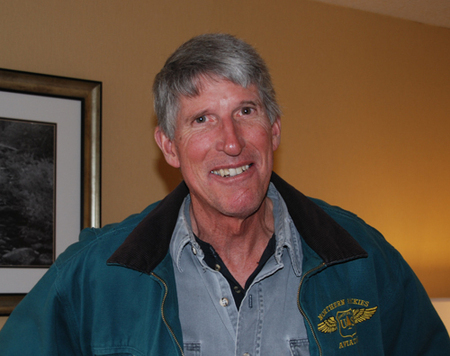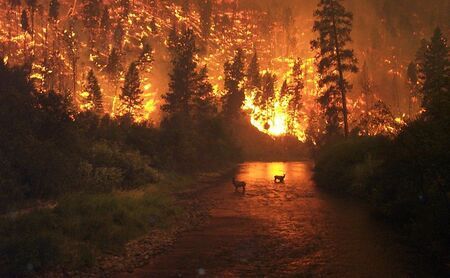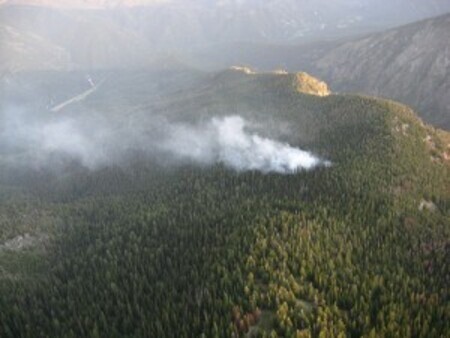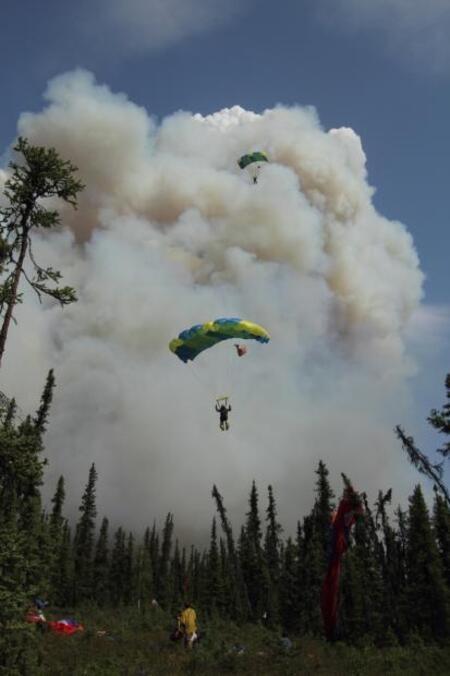Episode 21 : Smokejumping : an interview with Dick hulla Item Info
In this episode, titled “Smokejumping,” we hear from Dick Hulla, who not only worked as the first river ranger in the Selway-Bitterroot wilderness, but also jumped into fires in many places in the western United States, including the Selway-Bitterroot during the time when the “let-burn” policy first came into play.
Dick grew up in Missoula, and applied to work in the Forest Service at the age in 18 in the late 1960’s, right after the passage of the Wilderness Act. Throughout college at the University of Montana, Dick spent the summers working in the wilderness, where he met and impressed Emil Keck, who oversaw his work maintaining trails and bridges. Dick went on to work as a river ranger, providing vital information to the Forest Service toward what was to become the unique “one-launch-per-day” rafting policy. He later smoke jumped, and earned his pilot’s license, working as a backcountry pilot and firefighter throughout the 1970’s and 80’s. Here, he tells us what is involved in smokejumping on a backcountry fire, and describes the practice of “herding” a wildfire that is to be allowed to burn.
Episode 21 : Smokejumping : an interview with Dick hulla [transcript]
00:00:00:00 - 00:00:29:05 Debbie Lee: Welcome to the Subway Bitterroot Wilderness History Project, which is made possible by a grant from the National Endowment for the Humanities, the University of Idaho and Washington State University. Part of the project’s mission is to collect, preserve, and make public oral histories documenting the history and people of the subway. Bitterroot wilderness. For more information, please visit our website at SPW lib argue Idaho edu.
00:00:29:07 - 00:00:54:05 Debbie Lee: And then I think people. I think people get so much out of being in a wilderness setting once you take away cars and money and telephones, people are different and they are different to each other, I think. and and then they draw on things in themselves that maybe are a little rusty from our crazy life out here.
00:00:54:05 - 00:01:25:08 Debbie Lee: Now, I think the ways that people get along when they’re isolated in a place like that, that they place that they want to be. I really it’s a wonderful thing.
00:01:25:10 - 00:01:47:18 Debbie Lee: Thank you for joining us for the 21st episode of the South Bitterroot Wilderness History Project. In this episode, titled Smoke Jumping, we hear from Dick Halla, who not only worked as the first River Ranger in the South Bitterroot Wilderness, but also jumped into fires in many places in the western United States, including the Snowy Bitterroot. During the time when the let burn policy first came into play.
00:01:47:20 - 00:02:15:01 Debbie Lee: Dick grew up in Missoula and applied to work in the Forest Service at the age of 18. In the late 1960s, right after the passage of the Wilderness Act. Throughout college at the University of Montana, Dick spent the summers working in the wilderness, where he met an impressed Macek, who oversaw his work maintaining trails and bridges. Dick went on to work as a river ranger, providing vital information to the Forest Service toward what was to become the unique one launch per day rafting policy.
00:02:15:03 - 00:02:32:15 Debbie Lee: He later smoked, jumped and earned his pilot’s license, working as a backcountry pilot and firefighter throughout the 1970s and 80s. Here, he tells us what is involved in smoke jumping on a backcountry fire, and describes the practice of herding a wildfire that is to be allowed to burn.
00:02:32:17 - 00:02:54:24 Debbie Lee: Could you, walk walk me through what it’s like to do a smoke jump from, you know, a pilot and a and a smoke jumpers point of view. Do you, you know, how do you prepare? Where are you supposed to draw? You know what equipment. What do you do when you hit the ground?
00:02:54:26 - 00:03:27:27 Dick Hulla: Well, from the the jumper part of it, I mean, that’s, the tip of the spear, you know, it’s, it’s a lot, a lot like a military action, I think. And people that have been in the military, equate it to to, you know, a military type of operation. But you’re, by the time, by the time you’re jumping fires for the Forest Service, you’re you’re pretty well trained.
00:03:28:00 - 00:04:01:01 Dick Hulla: the the training is, is superb. And they can take people, young men who have never, ever even been in an airplane. let alone, parachute jump before. And within three weeks, if you make it through the training, you’re, you’re prepared. And so the training is quite good. The firefight as far as the airplanes and the parachute portion, the firefighting portion, they expect you to to come in with that background already.
00:04:01:04 - 00:04:10:05 Dick Hulla: And that includes, tool handling and chainsaw, split, you know, the tools of the trade. And you, you’ve already.
00:04:10:08 - 00:04:11:10 Debbie Lee: So when you.
00:04:11:12 - 00:04:12:00 Dick Hulla: Say that.
00:04:12:04 - 00:04:22:19 Debbie Lee: You’re, you’re, you get a phone call that says, we want you to jump this fire, and so is everything already packed for you. Ready to go pack your own stuff.
00:04:22:19 - 00:04:50:07 Dick Hulla: Now you’re expected. And most of the fires, I see the usual, pattern was that, lightning. And most of our fires were lightning type fires. And so a lightning storm would happen late in the afternoon. And so if, you’re in Greenville, for example, you were close by, an aid. You oftentimes were flying right behind the storms or during the storms.
00:04:50:09 - 00:05:15:07 Dick Hulla: You know, you could be seeing ground strikes, depending on the situation. They could have somebody up just prioritizing, prioritizing fires at that time and just saying, okay, we want you to go there and they’re there. So a lot of times, you were on a fire within, you know, an hour of it, of the lightning strike. other situations.
00:05:15:07 - 00:05:26:24 Dick Hulla: Yeah. You might get a phone call and say, well, we got a fire over in Wyoming, and we’re going to leave Missoula at 430 and and be over the fire. Just at first light.
00:05:26:26 - 00:05:30:12 Debbie Lee: At first light is like, Don. Yeah, yeah, yeah.
00:05:30:12 - 00:05:32:07 Dick Hulla: And you got to have the decency.
00:05:32:07 - 00:05:32:29 Debbie Lee: You got to see.
00:05:32:29 - 00:05:55:21 Dick Hulla: Yeah. You got to be able to see. So but we I remember they don’t do this so much now, but then those in the 70s and 80s, they, you know, you’d take off that big 4:00 in the morning and have to circle over the fire for 15 or 20 minutes until it got light enough to that. And that was a great strategy.
00:05:55:21 - 00:06:16:27 Dick Hulla: I really like that because you’ve got you have good air. Jumping in in the morning is way better than jumping in the afternoon because of the the air the afternoon. You have wind that’s a lot hotter thermals. There’s less dense mornings. Great time to jump.
00:06:17:00 - 00:06:19:24 Debbie Lee: And do you land in the obviously you land and trees.
00:06:19:24 - 00:06:48:18 Dick Hulla: Sometimes you try to pick a spot near the fire that’s going to let you land on the ground, you know, safely. if you do have to land in trees, they try to pick, type group trees. Right? Pride reproduction. That’s you’re not going to fall out of a tree and run into the side of a large, 200ft tall pine tree and not hang up.
00:06:48:20 - 00:06:54:12 Debbie Lee: So then how do you get your parachute out of the trees?
00:06:54:14 - 00:07:20:19 Dick Hulla: Well, there’s procedures for letting yourself out of the tree. If you do hang out, it’s called a letdown. And you learn that in, you know, your training. And then every year you go through, refresher where if you redo all of the procedures, so the first thing is to get yourself down out of the tree, and you can you’re expected to be able to do that, in a certain amount of time.
00:07:20:19 - 00:07:45:16 Dick Hulla: It’s usually less than ten minutes. and you can safely repel out of the tree. You go and put out the fire, and then you come back, get your shoot, you get a climb the tree. if it’s a large tree that you can safely climb, or if, smaller trees, you just cut them down and retrieve your chute or pull it out one way or the other.
00:07:45:16 - 00:07:48:09 Dick Hulla: Yep. The general practice is to climb.
00:07:48:09 - 00:08:00:09 Debbie Lee: The tree, so you have to be really physically fit. Yes. have you ever encountered anyone who couldn’t actually do it right to kind of say, I can’t handle this physically?
00:08:00:11 - 00:08:34:12 Dick Hulla: No, but there was, a lot of people who who didn’t like climbing trees, who couldn’t ever were comfortable. I mean, you know, everybody had to do it. And one of the, stations, at the University, that’s the ground school, they have an exit tower where you learn how to exit the plane. They have a landing simulator where you learn how to do your landing roles, and they had tree climbing poles, or you learn tree climbing techniques, and there’s always people that like doing that or didn’t mind doing it.
00:08:34:14 - 00:08:58:24 Dick Hulla: I mean, some people actually liked it. I was one of the guys and I liked it. I always liked being up in climbing and I was good at it. It was never a problem. And you could make a lot of beer by getting hired by the people that didn’t like climbing. And you can get there shoots a lot of people over the years, you know, you just had a reputation.
00:08:58:24 - 00:09:07:04 Dick Hulla: If you were one of the guys that liked to climb and yeah, get the cargo. I mean, yeah, usually you were climbing for cargo more than you were for personnel.
00:09:07:04 - 00:09:08:12 Debbie Lee: And yeah.
00:09:08:15 - 00:09:32:20 Dick Hulla: The after the jumpers are all on the ground safely, they dropped off at a low altitude. The plane comes in and drops, cargo boxes that have a parachute on them also. And they’re not steerable. There’s nobody steering or chutes. Right. And it’s really dependent on the pilot skill as to because the pilot’s the one that’s positioning the plane.
00:09:32:20 - 00:09:54:17 Dick Hulla: And he also is the one that’s call and telling the people in the back when to throw the cargo out. And so if you got a really good pilot and, you can get it into the cargo, into a small spot and you don’t have to do as much climbing, and that’s, that’s a good thing because you’re good to the fire quicker with your tools.
00:09:54:19 - 00:10:01:08 Dick Hulla: And that’s also you don’t have to spend the energy to go climb trees.
00:10:01:10 - 00:10:08:18 Debbie Lee: When you, were smoke jumping, did you jump onto the subway better route? Very much, or were you kind of all over?
00:10:08:20 - 00:10:25:19 Dick Hulla: I was all over it, but I did make a number of jumps. and most that I jumped right at subway lodge when the people who owned the lodge were back there with their clients. And we jumped right in there on their airstrip.
00:10:25:21 - 00:10:27:18 Debbie Lee: was that, Freddy.
00:10:27:20 - 00:10:28:12 Dick Hulla: Freddy and Everett.
00:10:28:12 - 00:10:29:01 Debbie Lee: Years.
00:10:29:03 - 00:11:08:27 Dick Hulla: Who I knew quite well because I worked for him and Aspen, one winter and I was in the back of a load. It was when I was still early in my career. So I. You know, I wasn’t squatting overhead and and, it was during the 1974, the independence fire, which was, large, and this was again early on and, that whole, Bob much this program of, let the fires run their course in the wilderness and that particular fire, they call it the independent fire that started on July 4th.
00:11:08:29 - 00:11:33:21 Dick Hulla: And by then, smokejumpers were calling it the most correct black hole because we kept getting sucked back there. And for the smoke jumpers, those, those fires presented all kinds of problems for us because there was never any clear direction on how they wanted them all they wanted us to do was to hurt. I mean, you don’t hurt wildfire.
00:11:33:23 - 00:11:35:15 Debbie Lee: But also, what does that mean?
00:11:35:17 - 00:12:01:03 Dick Hulla: Well, they said we don’t want it to go here. It’s okay if it goes out this direction, but we don’t want it to go that direction. And it’s the talk about, these safety issues. And those fires were those were the situations that, you know, they talk about the 18 situation. So shout watch out! Or the 18 standard firefighter or all of them.
00:12:01:05 - 00:12:28:05 Dick Hulla: And one of them should be, hurting wildfires because that’s definitely a situation that shouts, watch out, you don’t have an anchor point. That’s the main problem. They tell you that, well, we want you to start right here, you know? Yeah. this particular fire had slopped over on, on, Bear Creek was about four miles up Bear Creek and it was burning on.
00:12:28:12 - 00:12:40:03 Dick Hulla: And it’s multi thousand acres on one side. And they when it went across jumped across Bear Creek, they didn’t want it to go, they wanted that control.
00:12:40:06 - 00:12:41:08 Debbie Lee: But not the other side.
00:12:41:09 - 00:12:47:25 Dick Hulla: But not the other side which is Bear Creek was a pretty good anchor. And so yeah that was.
00:12:47:25 - 00:12:49:01 Debbie Lee: So what’s an anchor?
00:12:49:01 - 00:13:02:06 Dick Hulla: That’s just well, where where you start digging you as you move around the fire, you want to be anchored into something that’s so the fire doesn’t come back around behind you.
00:13:02:08 - 00:13:04:05 Debbie Lee: I see.
00:13:04:08 - 00:13:45:22 Dick Hulla: so generally an anchor point is, is a, a river, a road, a rockslide, some kind of a natural spot that’s going to keep the fire from hooking around behind you. And that’s okay. You know, you learned that early on in your firefighting career that you don’t just generally unless you can see your anchor spot. And if the small enough fire or see where you started, but as soon as you lose sight of where you started, you either have to have people back there watching that, or you have to have a real good, strong anchor point.
00:13:45:25 - 00:13:53:12 Dick Hulla: And a lot of those fires don’t have good anchor points. The management type.
00:13:53:14 - 00:13:55:11 Debbie Lee: You mean the ones that are allowed to burn?
00:13:55:11 - 00:13:58:24 Dick Hulla: Yes. Where they just tell you to go in and hurt it.
00:13:58:27 - 00:14:00:21 Debbie Lee: Do they still hurt fires?
00:14:00:21 - 00:14:05:12 Dick Hulla: They still have. yeah. That’s still going on.
00:14:05:14 - 00:14:10:20 Debbie Lee: Yeah. And is it to protect the in holdings and structures back.
00:14:10:21 - 00:14:35:25 Dick Hulla: A lot of different reasons. But yeah. And there’s all kinds of things have progressed. And, you know, I mean, there’s a lot of, a lot of policies and a lot of, technique and strategies that have evolved over the years to kind of mitigate that. But at the end of it to in my mind, it’s still, still a problem.
00:14:35:27 - 00:14:42:25 Dick Hulla: They haven’t solved it completely. Interesting. Well.
00:14:42:28 - 00:15:06:06 Debbie Lee: Thank you for joining us for this episode of the Selway Bitterroot Wilderness History Project, which has been made possible by the National Endowment for the Humanities. The University of Idaho, and Washington State University. The project coordinator is Debbie Lee, recorded and produced by Aaron Jepson.
Gallery
- Title:
- Episode 21 : Smokejumping : an interview with Dick hulla
- Creator:
- Debbie Lee; Dick Hulla
- Date Created (ISO Standard):
- 2011-04-15
- Description:
- Interviewee: Dick Hulla | Interviewer: Debbie Lee | Location: Missoula, Montana | Date: April 15, 2011 | In this episode, titled 'Smokejumping,' we hear from Dick Hulla, who not only worked as the first river ranger in the Selway-Bitterroot wilderness, but also jumped into fires in many places in the western United States, including the Selway-Bitterroot during the time when the 'let-burn' policy first came into play.
- Subjects:
- podcasts early days smokejumping fire suppression fire firefighting river ranger fire policy
- Section:
- Wilderness Voices
- Location:
- Selway-Bitterroot Wilderness (Idaho and Mont.)
- Publisher:
- Wilderness Voices, The Selway-Bitteroot Wilderness History Project, https://selwaybitterrootproject.wordpress.com/
- Original URL:
- https://selwaybitterrootproject.wordpress.com/2012/05/30/smokejumping/
- Source Identifier:
- Selway-Podcast-ep21
- Type:
- Sound
- Format:
- audio/mp3
- Language:
- eng
- Preferred Citation:
- "Episode 21 : Smokejumping : an interview with Dick hulla", The Selway-Bitterroot Wilderness History Project, University of Idaho Library Digital Collections, https://www.lib.uidaho.edu/digital/sbw/items/sbw303.html
- Rights:
- Copyright: The Selway-Bitteroot Wilderness History Project. In Copyright - Educational Use Permitted. For more information, please contact University of Idaho Library Special Collections and Archives Department at libspec@uidaho.edu.
- Standardized Rights:
- http://rightsstatements.org/vocab/InC-EDU/1.0/




